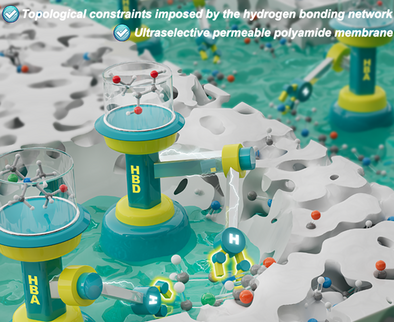Ultraselective Permeable Polyamide Membranes Prepared via Interfacial Polymerization of Alkane and Deep Eutectic Solvent
Graphical Abstract
A green interfacial polymerization platform that can eliminate side reactions was designed to precisely regulate the preparation of narrow pore size polyamide membranes through a dynamic 3D hydrogen bonding network. In addition, the platform has unprecedented universality, and the membranes produced have an order of magnitude higher selectivity for NaCl/Na2SO4, as well as excellent permeability.
Abstract
Conventional alkane/water interfacial polymerization encounters significant challenges in constructing polyamide membranes with precise nanoconfinement. This requires advanced strategies that simultaneously slow the diffusion kinetics and suppress side reactions, facilitating the formation of a well-defined pore architecture. Herein, we introduced an alkane/deep eutectic solvent (DES) interfacial polymerization approach, allowing the preparation of ultraselective permeable polyamide membranes. The DES, acting as an anhydrous solvent, effectively prevents side reactions, while its robust hydrogen bonding network finely regulates the diffusion behavior of amine monomers and induces the assembly of oligomers, affording a polyamide membrane with uniform subnanometer pores. Notably, the strong hydrogen bonding network of DES enhances the solvation of amine monomers, which further promotes the tuning of the membrane structures and functions. The polyamide membrane produced using specific DES (D-PA) revealed an exceptional NaCl/Na2SO4 (165.8) separation selectivity, an order of magnitude larger than that of conventional polyamide membranes, coupled with impressive water permeance of up to 18.4 L m−2 h−1 bar−1. This strategy offers a paradigm shift in the fabrication of ultraselective permeable polyamide membranes for advanced water purification system.
Conflict of Interests
The authors declare no conflict of interest.
Open Research
Data Availability Statement
The data that support the findings of this study are available from the corresponding author upon reasonable request.





